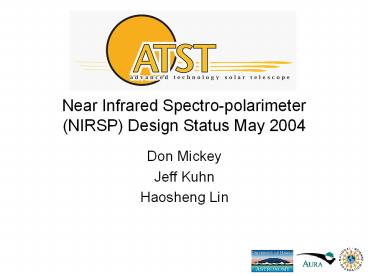Near Infrared Spectro-polarimeter (NIRSP) Design Status May 2004 - PowerPoint PPT Presentation
1 / 11
Title:
Near Infrared Spectro-polarimeter (NIRSP) Design Status May 2004
Description:
Near Infrared Spectro-polarimeter (NIRSP) Design Status May 2004. Don Mickey. Jeff Kuhn ... Two spectrograph modules, one on coud platform and the other at Nasmyth. ... – PowerPoint PPT presentation
Number of Views:165
Avg rating:3.0/5.0
Title: Near Infrared Spectro-polarimeter (NIRSP) Design Status May 2004
1
Near Infrared Spectro-polarimeter (NIRSP) Design
Status May 2004
- Don Mickey
- Jeff Kuhn
- Haosheng Lin
2
NIRSP Modules
- Two spectrograph modules, one on coudé platform
and the other at Nasmyth. - Common basic design common camera.
- Coudé high spatial resolution, multi-camera
capable. Warm optics on optical bench. AO
observations of limited field. - Nasmyth Coronal observations and wide-field disk
observations. Cold optics.
3
NIRSP Requirements
4
NIRSP Coudé Unit
- Feed at f40
- Spatial scale 0.776 mm / arc sec
- Field lens near entrance slit (if required)
- Makes beam telecentric
- Slit nominal 36 µm
- Spatial sampling 0.046 arc sec
- Grating is R2 (tan ? 2) echelle
- Angular dispersion 4/? µrad/pm (near-Littrow)
- Reflective Littrow layout, off-axis parabola
- Coma-corrected at any grating angle
- Minimal astigmatism
- Spectrograph magnification 1.0
5
NIRSP Coudé, more
- Collimator focal length 2.25 m
- Geometric pupil diameter 56 mm
- Linear dispersion 5.75 µm/pm at ? 1.565 µm
- Grating width 300 mm (projected width 135 mm)
- Diffraction image width at focal plane is 26 µm
- Slit diffraction overfills grating 12 light
loss at l 1.565 - Ruling frequency 87 mm-1, or TBD
- Detector like Hawaii-2 RG, 1 ? 2 mosaic
- 18 µm pixels, bin 2 ? 2
- Field 95 arc sec
- Spectral sampling 6.3 pm
- Resolving power 200,000 at l 1.565
- Increase f to 3m and w to 400 mm gives R270,000
6
Multiple Slits
- At Coudé, the FPA width covers 6.4 nm at l
1.565. The optical quality is good over the
entire field, so we might think of using a
narrow-band blocker and up to six slits.
7
NIRSP Nasmyth
- Feed at f13.08 (same as Gregorian image)
- Spatial scale 0.254 mm / arc sec
- Field lens near entrance slit
- Makes beam telecentric
- Slit nominal 108 µm for coronal observations, 18
µm for disk observations - Spatial sampling 0.425 arc sec to 0.07 arc sec
- Grating is R2 (tan ? 2) echelle
- Angular dispersion 4/? µrad/pm (near-Littrow)
- Reflective Littrow layout, off-axis parabola
- Coma-corrected at any grating angle
- Minimal astigmatism
- Spectrograph magnification 1.0
8
NIRSP Nasmyth, more
- Collimator focal length 1.3 m
- Geometric pupil diameter 99 mm
- Linear dispersion 3.32 µm/pm at ? 1.565 µm
- Grating width 300 mm (projected width 135 mm)
- Diffraction image width at focal plane is 15 µm
- Slit diffraction overfills grating 20 light
loss at l 1.565 with 18 µm slit (3 loss with
108 µm slit) - Ruling frequency 87 mm-1, or TBD
- Detector like Hawaii-2 RG, 1 ? 2 mosaic
- 18 µm pixels, bin 6 ? 6 (or more!) for corona
- Field 290 arc sec
- Spectral sampling 5.4 pm photosphere 22 pm
corona 1.07 µm - Resolving power 225,000 at l 1.565
9
Nasmyth Scanning
- How do we scan the image at Nasmyth?
- Scan the telescope?
- Scan the spectrograph?
- Add a scanning mirror to the relay optics?
10
Tip-tilt at Nasmyth
- Nasmyth observations need tip-tilt correction
- T-T options
- Active secondary
- Active second relay mirror
- Image moves 2.5 mm for 10 arc sec pupil moves
1.2 mm. - Add a pupil mirror to the relay optics
11
Nasmyth Context Image
- How do we get a context image?
- Multiple slits make slit viewer difficult.
- Dichroic or bandpass ahead of slit?
- Infrared, or visible, context image?

